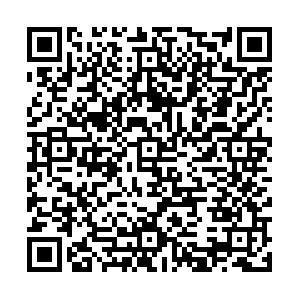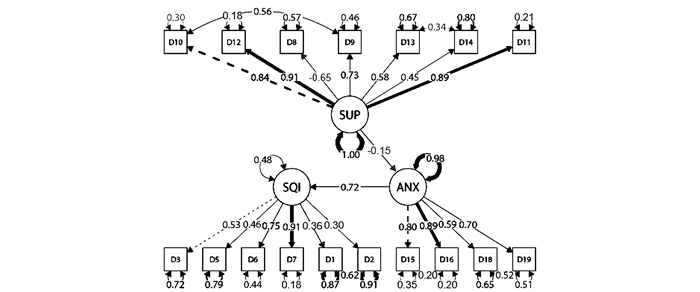Study on relationship among social support, anxiety and sleep quality of residents in Shanghai under COVID-19 epidemic
-
摘要:
目的 了解上海市社区居民在COVID-19疫情期间其社会支持、焦虑及睡眠质量的情况,并分析三者之间的关系。 方法 采用问卷对居民的社会支持、焦虑以及睡眠质量情况进行调查,问卷选自社会支持评定量表、焦虑自评量表及匹茨堡睡眠质量指数量表,调查上海市社区居民在COVID-19疫情下社会支持、焦虑、睡眠质量情况并对其可能的影响因素进行分析,最后拟合结构方程模型,探索三者的关系。 结果 共回收问卷258份,其中有效问卷237份。结果显示在不同最高学历的居民之间,其睡眠质量(P=0.004)及社会支持(P=0.009)间的差异有统计学意义。结构方程模型拟合指数CFI=0.929,NFI=0.891,IFI=0.930,NNFI=0.907,RMSEA=0.082,χ2 /df=2.599,拟合效果良好,其结果表明居民所受社会支持可在一定程度上影响其焦虑程度(r=-0.15),所受社会支持越高,其焦虑程度越低。而焦虑程度可影响睡眠质量(r=0.72),焦虑程度越高,睡眠质量越差。 结论 COVID-19疫情期间上海市居民的社会支持与其焦虑程度相关,而焦虑程度与睡眠质量相关,可通过提升居民的社会支持,降低其焦虑程度,从而提高其睡眠质量。 Abstract:Objective To describe the social support, anxiety, and sleep quality of residents in the District of Shanghai during the COVID-19 and to analyze the to correlation of these factors. Methods A structured questionnaire was used to investigate residents' social support, anxiety, and sleep quality. The questionnaire consisted of social support rate scale, the self-rating anxiety scale (SAS) and Pittsburgh sleep quality index (PSQI), investigated the social support, anxiety, and sleep quality of residents in the District of Shanghai under the COVID-19 epidemic and analyzed their potential influencing factors. Structural equation model was constructed to understand the relationship among these factors. Results A total of 258 questionnaires were collected, with 237 being eligible for analyzeing. The results showed that there were statistically significant differences in sleep quality (P=0.004) and social support (P=0.009) among residents with different highest education levels. The structural equation model-fitting indices were CFI=0.929, NFI=0.891, IFI=0.930, NNFI=0.907, RMSEA=0.082, χ2 /df =2.599. It indicated that the fitting degree was good. The results showed that the social support of residents could affect their anxiety degree to some extent (r=-0.15). The higher the social support, the lower the anxiety degree they had. Moreover, the degree of anxiety could affect the sleep quality ( r=0.72), and the higher the degree of anxiety, the worse the sleep quality they had. Conclusion During the epidemic of COVID-19, residents' social support is related to their anxiety level, and the anxiety level is related to their sleep quality. By improving residents' support, their degree of anxiety could be reduced to improve their sleep quality. -
Key words:
- COVID-19 /
- Social support /
- Anxiety /
- Quality of sleep /
- Structural equation model
-
图 1 2020年上海市徐汇区居民社会支持、焦虑及睡眠质量之间关系的结构方程模型
注:D1~D19的含义见表 2;SUP:社会支持;SQI:睡眠质量;ANX:焦虑程度。
Figure 1. Structural equation model of the relationship between social support, anxiety, and sleep quality among residents in Xuhui District, Shanghai in 2020
表 1 2020年上海市徐汇区居民人口学特征及不同特征人群焦虑程度、睡眠质量及社会支持的差异[n (%)]
Table 1. Demographic characteristics of residents in Xuhui District, Shanghai in 2020, and differences in anxiety, sleep quality, and social support among groups of different characteristics [n (%)]
人口学特征 人数[n(%)] 焦虑程度 睡眠质量 社会支持 得分(x±s) P值 t/F值 得分(x±s) P值 t/F值 得分(x±s) P值 t/F值 性别 0.059 1.898 0.131 1.516 0.297 1.045 男 98(41.3) 5.28±3.15 5.00±4.28 20.69±5.73 女 118(49.8) 6.09±3.15 5.87±4.36 20.13±5.90 不详 21(8.9) 婚姻状况 0.518 0.660 0.211 1.567 0.916 0.088 未婚 37(15.6) 6.19±3.13 4.97±4.13 20.05±4.72 已婚 162(68.4) 5.73±3.21 5.28±4.39 20.30±6.01 丧偶、离异或分居 25(10.5) 5.24±2.83 6.88±4.75 20.68±5.10 不详 13(5.5) 最高学历 0.465 0.900 0.004 3.959 0.009 3.469 未受过学校教育 8(3.4) 4.63±2.33 5.00±4.63 18.13±5.08 小学 11(4.6) 7.18±4.09 9.26±4.43 17.38±6.27 初中 46(19.4) 5.80±3.06 6.63±4.49 19.59±5.39 高中或中专 74(31.2) 5.37±2.73 5.47±4.46 21.13±5.68 大专及以上 88(37.1) 6.00±3.48 4.74±3.85 21.31±5.82 不详 10(4.2) 职业 0.101 1.739 0.582 0.807 0.550 0.846 学生 7(3.0) 7.43±4.39 5.29±5.09 21.57±5.65 医疗卫生人员 26(11.0) 7.23±3.85 6.35±4.61 22.45±5.84 国家机关、事业单位人员 14(5.9) 5.79±3.04 4.93±3.65 19.23±6.57 专业技术人员、公司职员 19(8.0) 6.42±3.70 4.21±3.85 20.81±5.60 个体经营者 5(2.1) 6.40±3.29 7.00±3.16 18.20±3.90 退休人员 127(53.6) 5.32±2.65 5.46±4.36 20.37±5.56 自由职业者 11(4.6) 5.18±3.49 6.91±5.09 22.09±2.81 不详 28(11.9) 疫情前月收入(元) 0.151 1.700 0.111 1.903 0.097 1.990 <3 000 20(8.4) 7.56±3.01 7.35±5.24 19.96±5.48 3 000~<5 000 113(47.7) 5.54±2.87 5.66±4.31 20.22±5.52 5 000~<10 000 79(33.3) 5.98±3.31 5.15±4.08 21.25±5.65 10 000~<20 000 12(5.1) 5.17±4.06 2.92±4.23 22.70±4.70 ≥20 000 3(1.3) 5.00±3.61 5.67±3.51 19.00±6.56 不详 10(4.2) 年龄(岁) 0.700 0.476 0.301 1.225 0.772 0.374 20~<50 77(33.9) 6.08±3.52 5.10±4.30 20.88±5.33 50~<60 33(14.5) 5.37±3.08 6.55±4.14 20.34±4.93 60~<70 88(38.8) 5.74±2.98 5.76±4.38 20.52±5.71 ≥70 29(12.8) 5.53±2.86 4.79±4.40 19.57±7.69 不详 10(4.2) 注:分类不详的数据计算其(x±s)无意义,故对应栏为空。 表 2 2020年上海市徐汇区居民睡眠质量、焦虑及社会支持关系的结构方程模型拟合结果
Table 2. Structural equation model fitting results of the relationship between sleep quality, anxiety, and social support among residents in Xuhui District, Shanghai in 2020
模型系数 回归系数 $ {s_{\overline x }}$ 标化回归系数 D1-不能在30 min内入睡(睡眠质量) 0.902 0.190 0.359 D2-早醒(睡眠质量) 0.821 0.200 0.298 D3-做噩梦(睡眠质量) 1.000 <0.001 0.531 D5-开车、吃饭或参加社会活动时难以保持清醒状态(睡眠质量) 1.288 0.224 0.462 D6-反应迟钝(睡眠质量) 1.338 0.171 0.746 D7-集中注意力困难(睡眠质量) 1.741 0.210 0.907 D8-感觉与其他人疏远或分离(社会支持) -0.767 0.070 -0.653 D9-与邻居之间相互关心(社会支持) 0.864 0.046 0.732 D10-与同事之间相互关心(社会支持) 1.000 <0.001 0.837 D11-从家庭成员得到的支持和帮助(社会支持) 1.100 0.064 0.888 D12-遇到急难时,得到安慰和关心(社会支持) 1.158 0.066 0.906 D13-遇到急难时,得到经济支持和解决实际问题的帮助(社会支持) 1.005 0.107 0.578 D14-遇到烦恼时,向他人倾诉或求助(社会支持) 0.692 0.098 0.452 D15-感到比往常更加神经过敏和焦虑(焦虑程度) 1.000 <0.001 0.803 D16-容易心烦意乱或感到恐慌(焦虑程度) 1.119 0.072 0.893 D18-感到无力且容易疲劳(焦虑程度) 0.795 0.099 0.594 D19-感到自我心跳较快(焦虑程度) 0.831 0.091 0.700 -
[1] Li Q, Guan X, Wu P, et al. Early transmission dynamics in Wuhan, China, of novel coronavirus-infected pneumonia[J]. N Engl J Med, 2020, 382(13): 1199-1207. DOI: 10.1056/nejmoa2001316. [2] Chan JF, Yuan SF, Kok KH, et al. A familial cluster of pneumonia associated with the 2019 novel coronavirus indicating person-to-person transmission: a study of a family cluster[J]. Lancet, 2020, 395(10223): 514-523. DOI: 10.1016/S0140-6736(20)30154-9. [3] Greenberg MR. Insidious trends and social/environmental justice: public health's challenge for responding to hazard events[J]. Am J Public Health, 2014, 104(10): 1802-1804. DOI: 10.2105/AJPH.2014.302162. [4] 周小东. 抗击新型冠状病毒肺炎疫情心理防线要点[J]. 解放军医药杂志, 2020, 32(2): 1-2. DOI: 10.3969/j.issn.2095-140X.2020.02.001.Zhou XD. Key points of psychological defense against COVID-19[J]. Med & Pharm J Chin PLA, 2020, 32(2): 1-2. DOI: 10.3969/j.issn.2095-140X.2020.02.001. [5] 王征宇, 迟玉芬. 焦虑自评量表(SAS)[J]. 上海精神医学, 1984, (2): 73-74. https://www.cnki.com.cn/Article/CJFDTOTAL-JSYI198402008.htmWang ZY, Chi YF. Self-rating anxiety scale (SAS)[J]. Shanghai Arch Psychiatry, 1984, (2): 73-74. https://www.cnki.com.cn/Article/CJFDTOTAL-JSYI198402008.htm [6] 肖水源. 《社会支持评定量表》的理论基础与研究应用[J]. 临床精神医学杂志, 1994, 4(2): 98-100. https://www.cnki.com.cn/Article/CJFDTOTAL-LCJS402.019.htmXiao SY. The theoretical basis and research application of social support rating scale[J]. J Clin Psychol Med, 1994, 4(2): 98-100. https://www.cnki.com.cn/Article/CJFDTOTAL-LCJS402.019.htm [7] 程开明. 结构方程模型的特点及应用[J]. 统计与决策, 2006, (10): 22-25. DOI: 10.13546/j.cnki.tjyjc.2006.10.008.Cheng KM. Characteristics and application of structural equation model[J]. Statistics & Decision, 2006, (10): 22-25. DOI: 10.13546/j.cnki.tjyjc.2006.10.008. [8] 张耀文, 李晓红, 李玉娟, 等. 529名居家民众疫情防控期间的睡眠质量调查与相关因素分析[J]. 世界睡眠医学杂志, 2020, 7(9): 1668-1670. DOI: 10.3969/j.issn.2095-7130.2020.09.079.Zhang YW, Li XH, Li YJ, et al. Sleep quality survey and related factors analysis of 529 people at home during epidemic prevention and control[J]. World Journal of Sleep Medicine, 2020, 7(9): 1668-1670. DOI: 10.3969/j.issn.2095-7130.2020.09.079. [9] 和红, 智欣. 新生代流动人口社会支持状况的社会人口学特征分析[J]. 人口研究, 2012, 36(5): 37-46. https://www.cnki.com.cn/Article/CJFDTOTAL-RKYZ201205005.htmHe H, Zhi X. Socio-demographic analysis of social support of the new generation migrants[J]. Population Research, 2012, 36(5): 37-46. https://www.cnki.com.cn/Article/CJFDTOTAL-RKYZ201205005.htm [10] 齐玉玲, 张秀敏, 史秀欣, 等. 城市社区老年人社会支持现状及影响因素研究[J]. 中国全科医学, 2016, 19(25): 3099-3102. DOI: 10.3969/j.issn.1007-9572.2016.25.021.Qi YL, Zhang XM, Shi XX, et al. Social support status and influencing factors of the elderly in urban community[J]. Chin Gen Pract, 2016, 19(25): 3099-3102. DOI: 10.3969/j.issn.1007-9572.2016.25.021. [11] Yang X, Yang XF, Kumar P, et al. Social support and clinical improvement in COVID-19 positive patients in China[J]. Nurs Outlook, 2020, 68(6): 830-837. DOI: 10.1016/j.outlook.2020.08.008. [12] Grey I, Arora T, Thomas J, et al. The role of perceived social support on depression and sleep during the COVID-19 pandemic[J]. Psychiatry Res, 2020, 293: 113452. DOI: 10.1016/j.psychres.2020.113452. [13] Ao YB, Zhu H, Meng FR, et al. The impact of social support on public anxiety amidst the COVID-19 pandemic in China[J]. Int J Environ Res Public Health, 2020, 17(23): E9097. DOI: 10.3390/ijerph17239097. [14] Sher L. COVID-19, anxiety, sleep disturbances and suicide[J]. Sleep Med, 2020, 70: 124. DOI: 10.1016/j.sleep.2020.04.019. [15] Xiao H, Zhang Y, Kong D, et al. The effects of social support on sleep quality of medical staff treating patients with coronavirus disease 2019 (COVID-19) in January and February 2020 in China[J]. Med Sci Monit, 2020, 26: e923549. DOI: 10.12659/MSM.923549. -





 下载:
下载:

